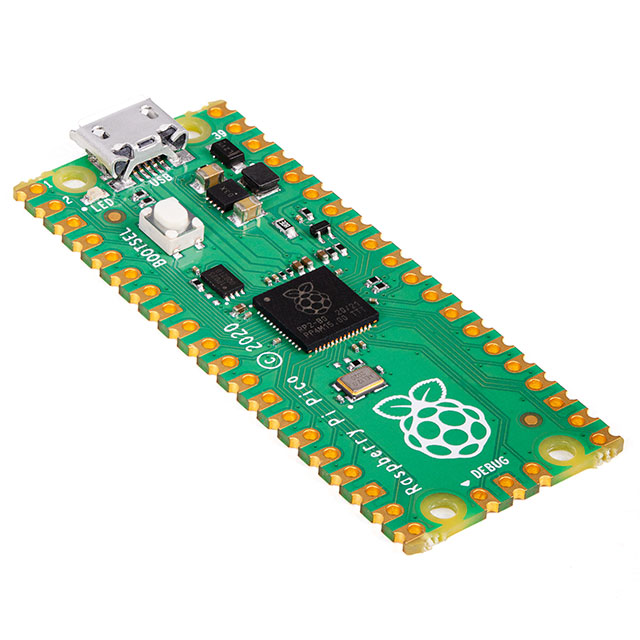Raspberry Pi Pico vs Arduino RP2040 Connect
2022-01-19 | By Maker.io Staff
Raspberry Pi SBC Raspberry Pi MCU
By this point, most of you have probably heard of the RP2040, the MCU designed and built by Raspberry Pi. This low-cost and high-performance microcontroller is perfect for a wide range of applications, and it comes with a few handy features. You can get the official RP2040 development board, called Raspberry Pi Pico, which already offers a variety of useful features right out of the box. Other manufacturers, such as Arduino, designed custom RP2040-based development boards. This article takes a quick look at one of them, and it compares the original Raspberry Pi RP2040 development board with the new RP2040 Connect board made by Arduino.
Featured Products:
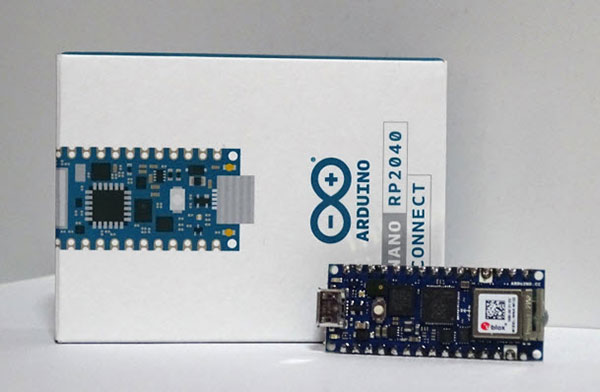 The Arduino RP2040 Connect sits next to its cardboard box.
The Arduino RP2040 Connect sits next to its cardboard box.
The RP2040 Microcontroller Characteristics
The RP2040 is a low-cost, high-performance dual-core MCU made by Raspberry Pi. Its key features include two Cortex M0+ 32-bit processing cores clocked at up to 133 MHz, 264 kilobytes of embedded SRAM, 30 GPIO pins with multiple functions, and dedicated on-chip accelerators for commonly used communication interfaces. Apart from digital I/O capabilities, the RP2040 also includes a four-channel ADC with an internal temperature sensor. The ADC is capable of 0.5M Sa/s using 12-bit conversion.
A Quick Look at the Original Raspberry Pi Pico Development Board
As mentioned, the Pico was the first official RP2040-based development board that advertises itself as a platform for makers and professionals alike. The original Pico board is about the same size as an Arduino Nano, and it features a wide variety of wired communication options. The biggest drawback of the Pico is its missing wireless communication capabilities. While the omission of a wireless communication chip brings down the cost of the Pico to an impressively low four dollars, it also means that you can’t use the Raspberry Pi Pico in IoT projects without additional hardware.
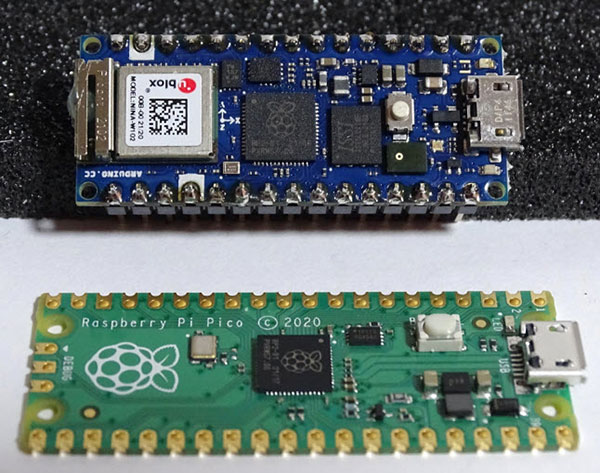 The Raspberry Pi Pico and the Arduino RP2040 Connect share the same MCU and a similar form factor.
The Raspberry Pi Pico and the Arduino RP2040 Connect share the same MCU and a similar form factor.
Most Notable Features of the Arduino RP2040 Connect
The Arduino RP2040 Connect is the first RP2040-based development board from Arduino. It features the same MCU as the Raspberry Pi Pico and thus has very similar specifications. The Pico, however, is slightly larger and also offers more usable GPIO pins. The Arduino RP2040 Connect comes in the same form-factor as the widely used Arduino Nano. Therefore, it can serve as a direct pin-compatible replacement of various Arduino Nano compatible development boards such as the Nano 33 IoT. Programming-wise, the Arduino RP2040 supports the classic Arduino IDE, the Arduino web-editor, and Python.
Either way, the most significant improvement introduced by the Arduino RP2040 Connect is its wireless communication capability. The onboard U-blox Nina W102 module allows you to use this fantastic little device in practically any IoT project. Besides WiFi support, the W102 module also lets you connect the RP2040 Connect to other Bluetooth devices. The improvements don’t end there, as the Arduino RP2040 Connect includes a built-in accelerometer, gyroscope, RGB LED, and a microphone. These features make this little powerhouse of a development board the perfect choice for even the most elaborate IoT project.
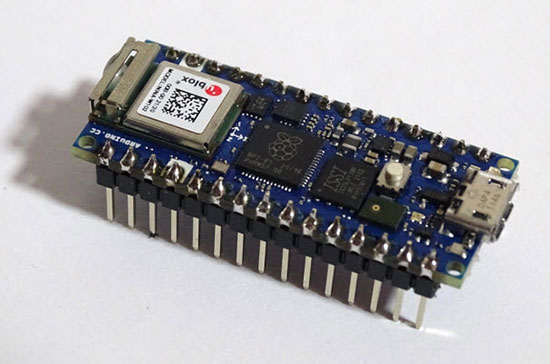 This close-up of the Arduino RP2040 Connect shows the Raspberry Pi MCU, the IMU axes, and the WiFi module next to its antenna.
This close-up of the Arduino RP2040 Connect shows the Raspberry Pi MCU, the IMU axes, and the WiFi module next to its antenna.
It’s incredibly important to remember that your IoT projects and security should always go hand in hand. For that purpose, the Arduino RP2040 Connect features the ATECC608A Cryptographic Co-processor that you can also find on all Arduino MKR boards. This co-processor includes secure hardware storage for up to 16 cryptographic keys and various symmetric hashing and encryption/decryption algorithms, such as SHA-256, HMAC, and AES-128. The ATECC608A also includes hardware support for asymmetric key signing, verification, and key-agreement procedures.
The many added features also mean that the Arduino RP2040 Connect is more expensive than the Raspberry Pi Pico. While the Pico only costs a very affordable $4, the Arduino RP2040 Connect is typically sold for around $27.
The Benefits of the RP2040
The RP2040 is an impressive microcontroller that features a 32-bit dual-core processing unit and various on-chip peripherals. The Raspberry Pi Pico is about the same size as an Arduino Nano, and it comes with numerous usable digital and analog GPIO pins. It supports various commonly used wired communication protocols out of the box. Unfortunately, the original Pico board doesn’t include a wireless communication module, which means you’ll need additional hardware to use it in an IoT project.
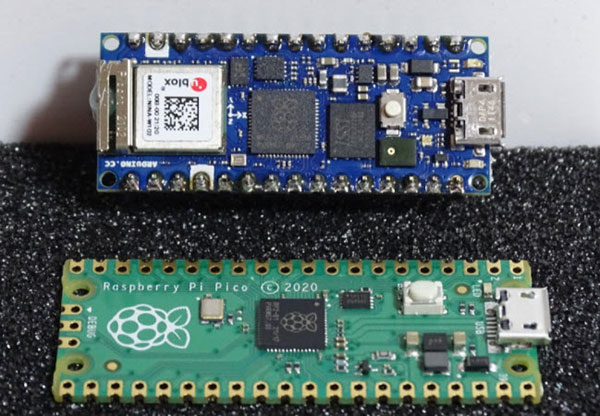 A comparison that shows the differences and similarities between the RP2040 Connect and the Raspberry Pi Pico.
A comparison that shows the differences and similarities between the RP2040 Connect and the Raspberry Pi Pico.
The Arduino RP2040 Connect can be seen as an upgraded version of the Raspberry Pi Pico, as it features a well-known wireless communication protocol and hardware security features. In addition, the RP2040 Connect comes with various onboard sensors. These features make it perfect for IoT and connected projects. On the other hand, the Raspberry Pi Pico is a cost-efficient development board that's well suited for many offline DIY projects.






